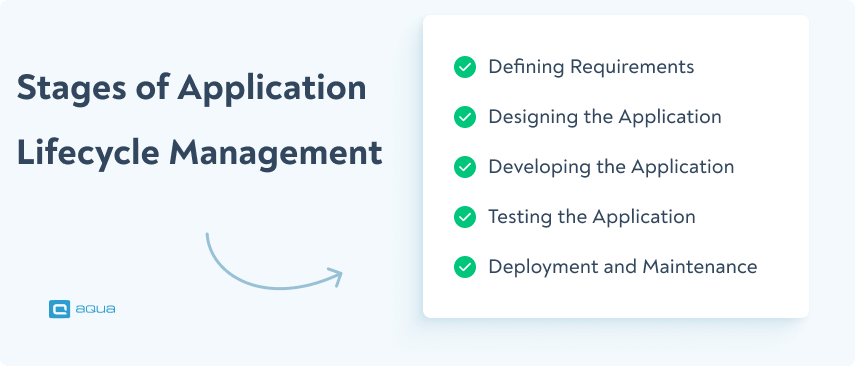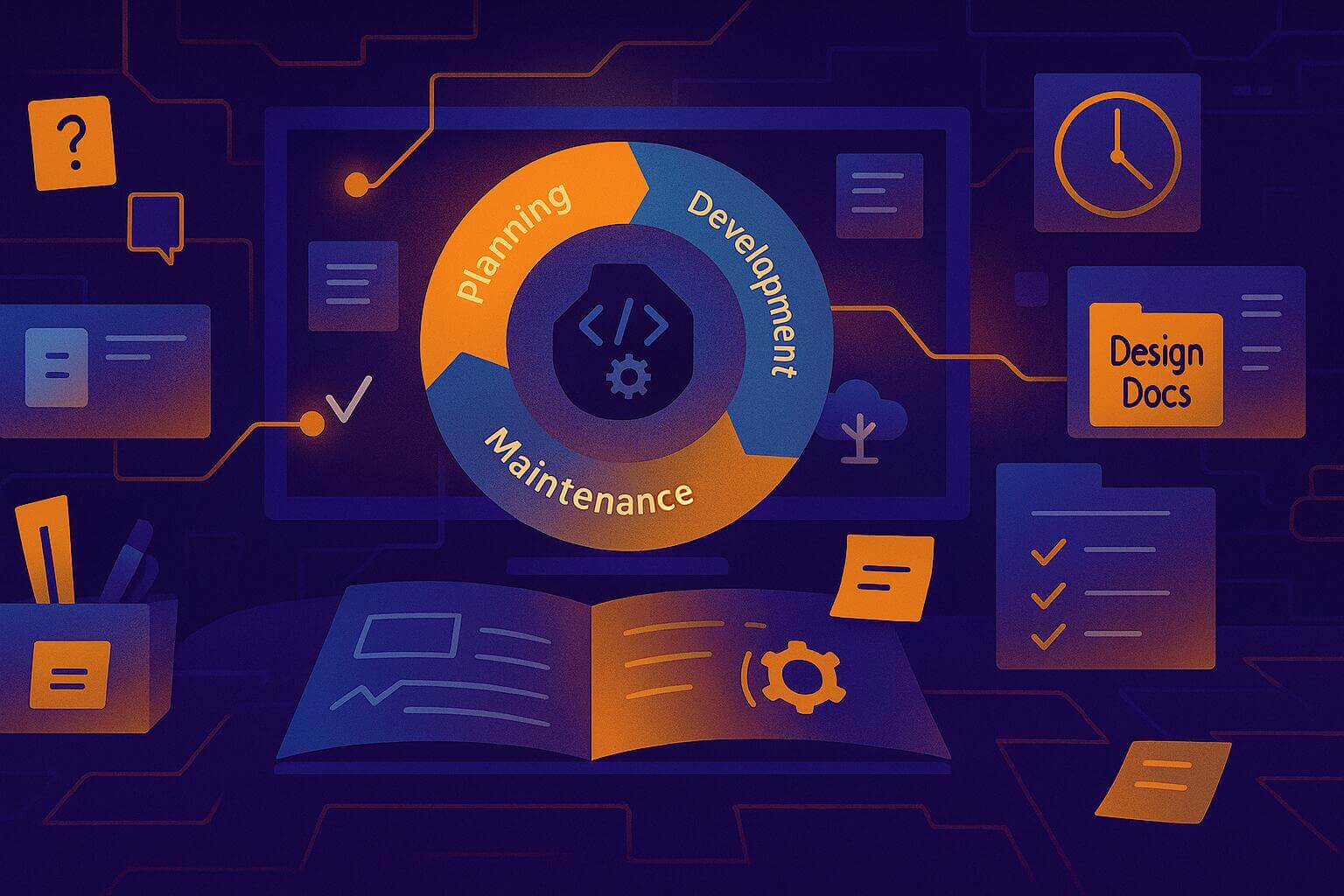In this guide, we’ll walk through everything you need to know about ALM – from what it actually is (no corporate jargon, promise) to how it works with DevOps. We will mainly focus on the QA perspective, while it is a bigger concept that applies to any role – including developers, project and product managers, and business owners.
Introduction to Application Lifecycle Management
ALM is the complete approach for managing software applications from the moment someone says, “Hey, I’ve got an idea” to the day you finally pull the plug on that legacy system nobody uses anymore. It’s the whole package – covering requirements, development, testing, deployment, and ongoing maintenance.
Here’s what ALM actually covers:
- Planning and requirements gathering
- Software architecture and design
- Coding and development
- Testing and quality assurance
- Deployment to production
- Ongoing maintenance and updates
- Eventual retirement
For QA teams specifically, application lifecycle management provides the structure to ensure that what you’re testing actually matches what was requested, and that bugs get fixed before users find them in production (because we all know how fun those emergency hotfixes are).
Importance of Application Lifecycle Management
Suppose you’ve ever been part of a project where nobody could find the original requirements. In that case, developers were coding features that nobody asked for, or testers were finding bugs that “weren’t actually bugs” – you know exactly why ALM is crucial for organisations.
In QA, application lifecycle management is particularly crucial. It creates that necessary traceability between what was requested, what was built, and what was tested. When that VP from marketing suddenly asks why a feature works differently than expected, you’ve got the receipts to show exactly where and when that decision was made.
Real-world impact of effective ALM
A global bank implemented proper application management lifecycle practices and reduced its critical production defects by 47% within a year. How? By ensuring requirements were properly tracked, tested, and validated through each phase of development.
Another case study showed a financial services company that successfully integrated its ALM tools with CI/CD pipelines. This company reduced release cycles from weeks to just days. The key was automating the connection between their requirements, test cases, and deployment processes.
For QA specifically, a well-implemented lifecycle management application means:
- Fewer “how did we miss this?” moments
- Clear testing priorities based on business value
- Improved test coverage directly tied to requirements
- Better collaboration with developers and product owners
- Less time wasted testing features that aren’t ready
The Application Lifecycle Management Process
The application lifecycle management process isn’t a one-and-done deal – it’s a continuous cycle that keeps your software healthy throughout its entire life. And for QA teams, understanding this process gives you context for where your testing fits into the bigger picture.
At its core, the ALM process connects five critical activities:
- Planning & Requirements: Defining what needs to be built and why
- Development: Building the actual code
- Testing: Verifying the code works as expected
- Deployment: Getting the code into production
- Maintenance: Keeping it running and improving over time
The real magic of ALM is that it creates connections between these activities. It’s not just that you go from phase 1 to phase 5 in order – it’s that each phase informs the others. Your test results influence future development priorities. Production issues guide new requirements. Everything is connected.
For testers, this means:
- Your test cases should trace back to specific requirements
- Your bug reports influence both current fixes and future requirements
- Your performance testing helps shape deployment strategies
This interconnected approach to software development is what makes ALM so powerful. Instead of throwing code over the wall between teams, everyone shares responsibility for the application’s overall health.
Stages of Application Lifecycle Management
Let’s break down each stage of the application lifecycle management in more detail, with a particular focus on what matters for QA professionals.
1. Defining Requirements
This first stage is where you figure out what you’re actually building. It’s about pinning down user needs, business goals, and technical constraints before writing a single line of code.
Key activities in this stage:
- Capturing user stories and use cases
- Defining acceptance criteria
- Setting quality standards and expectations
- Creating a requirements traceability matrix
For QA teams, this stage is gold. This is where you should be involved in defining what “done” looks like and what needs to be tested. The Indeed Career Guide on Agile Lifecycle Management notes that QA teams that participate in requirements definition catch up to 30% more issues before coding even begins.
Application lifecycle is assessment of whether the application is suiting the needs of the business and needs to be replaced.
Pro tip: Push for testability in requirements. Statements like “the system shall be user-friendly” are testing nightmares. Get them clarified into measurable criteria.
2. Designing the Application
Once you know what you’re building, it’s time to plan how to build it. This stage involves architecture decisions, technology selection, and creating design specifications.
Key activities in this stage:
- Selecting programming languages and frameworks
- Creating technical architecture diagrams
- Designing user interfaces and experiences
- Planning data models and storage strategies
For QA professionals, this is the time to:
- Identify potential technical risk areas that will need extra testing
- Begin drafting test strategies based on the architecture
- Review designs for testability issues
- Start planning what automation frameworks might work best
3. Developing the Application
Now comes the building phase, where developers turn designs into actual code. In modern ALM, this isn’t an isolated activity. It’s collaborative and iterative.
Key activities in this stage:
- Writing code according to design specifications
- Conducting code reviews and peer evaluations
- Performing unit testing
- Integrating components as they’re completed
QA’s role during development:
- Work with developers on unit test approaches
- Begin creating integration and system test cases
- Set up test environments that mirror production
- Start building automation frameworks for critical paths
The most successful teams integrate testing throughout the development process rather than waiting until a feature is “complete.”
4. Testing the Application
This is where QA takes centre stage. Testing is about validating that the application meets the requirements defined in stage one.
Key testing activities:
- Functional testing against requirements
- Performance and load testing
- Security testing
- User acceptance testing
- Regression testing
The most effective testing strategies use a mix of manual and automated approaches. The best QA teams prioritise test cases based on business risk and user impact rather than attempting to test everything equally.
ALM testing software and test management within ALM tools give you:
- Traceability from requirements to test cases
- Metrics on coverage and quality
- Defect tracking linked to requirements
- Test execution history and trends
5. Deployment and Maintenance
After successful testing, the application moves to production. But the application lifecycle management process doesn’t end there – it continues through the entire application lifespan.
Key activities in this stage:
- Release management and deployment
- Monitoring application performance
- Managing user feedback
- Implementing updates and patches
- Planning end-of-life strategies
For QA teams, responsibilities shift to:
- Testing hotfixes and patches
- Monitoring production behaviour against test predictions
- Validating that real-world usage matches test scenarios
- Refining test suites based on production issues
According to Microsoft’s guide on ALM, effective maintenance testing can reduce production incidents by up to 40% by catching issues before they impact users.

Benefits of Maintaining ALM
Implementing ALM brings substantial benefits to organisations, especially for QA teams. Here’s what you can expect:
Enhanced Visibility and Traceability
With ALM, you get complete traceability from requirements through testing and into production. This means:
- Every test case links back to a specific requirement
- Every bug connects to the affected components
- Every code change ties to a business need
For QA teams, this visibility means you can always answer the question “why are we testing this?” with concrete evidence.
Improved Team Collaboration
ALM breaks down silos between developers, testers, and business stakeholders. According to MGTech’s ALM integration guide, teams using integrated ALM solutions see:
- 23% improvement in on-time delivery
- 27% reduction in miscommunications
- 35% faster resolution of defects
This happens because everyone shares the same information and works in a unified system.
Higher Quality Software
Perhaps the most significant benefit for QA teams is the improvement in software quality. Research from HCL Software shows organisations implementing ALM experience:
- 64% reduction in critical defects found in production
- 42% improvement in first-pass test success rates
- 36% reduction in the cost to fix defects
| Benefit Area | Traditional Approach | With ALM Implementation |
|---|---|---|
| Defect Detection | 60% found during testing | 85% found during testing |
| Requirements Coverage | 70-80% test coverage | 95%+ test coverage |
| Test Efficiency | 55% of tests add value | 85% of tests add value |
| Release Delays | 40% of releases delayed | 15% of releases delayed |
Accelerated Delivery
The end result of proper ALM implementation is faster delivery without sacrificing quality. When requirements, development, and testing are all aligned, you eliminate wasteful rework and delays.
You can see an average 30% reduction in delivery time after implementing comprehensive ALM practices.
To implement these practices, you’ll need an all-around ALM. The good news is that we can offer you more: a comprehensive ALM with a strong focus on QA. Introducing aqua, an AI-powered comprehensive ALM and Test Management System.
Aqua cloud gives you everything ALM promises—without the complexity. From comprehensive requirements management and traceability to one-click bug reporting and 100% informational defects, aqua covers everything. AI-powered test generation (98% faster than manual generation) and deep automation integrations, aqua ensures your testing stays aligned, efficient, and future-proof. With integrated collaboration tools like Azure DevOps, Jira, and centralised defect tracking, you eliminate silos, reduce release delays, and boost quality—fast. If you’re ready to take your ALM strategy from theory to measurable impact, aqua cloud is the platform built to get you there.
Speed up your releases by 2x with a 100% AI-powered solution
Challenges in Application Lifecycle Management
Let’s be real – implementing ALM isn’t all rainbows and unicorns. There are some genuine hurdles you’ll need to jump. Here are the biggies:
Tool Integration Headaches
Getting different ALM tools to play nice together can be a pain. You might have:
- Jira for tickets
- Jenkins for CI/CD
- TestRail for test cases
- GitHub for code
Getting these to sync up properly is often the first major challenge. Every 2 out of 3 organisations struggle with tool integration issues.
Solution: Look for tools with pre-built integrations or consider middleware solutions like Tasktop or Kovair that can connect disparate systems.
Resistance to Change
People get comfortable with their ways of working. Developers might resist detailed requirements documentation. Testers might be used to their own spreadsheet-based test management.
Solution: Start small with the most painful integration points first. Show quick wins before rolling out comprehensive ALM. MGTech’s implementation best practices suggest beginning with a pilot team to demonstrate success.
Too Much Process, Not Enough Value
There’s a fine line between helpful structure and bureaucratic waste. Some ALM implementations become so rigid that they slow teams down rather than helping them.
Solution: Focus on the problems you’re trying to solve, not blindly implementing a textbook ALM approach. Ask “does this step add value?” for each part of your process.
Security Integration
With cybersecurity threats ever-present, integrating security throughout the ALM process is crucial but challenging. Many organisations still treat security as a last-minute checkpoint.
Solution: Adopt a secure application lifecycle management approach that builds security testing into each phase, from requirements through deployment. Application lifecycle management security should be a priority from the start, not an afterthought.
Complexity Management
As applications grow, managing the increasing complexity of requirements, code, and test cases becomes overwhelming.
Solution: Implement clear hierarchies and relationships in your ALM tools. Break large projects into manageable components with clear interfaces between them.
ALM Tools and Technologies
The right ALM software can make or break your implementation. Here’s a rundown of some top contenders, with a focus on testing features.
Popular ALM Tools Comparison
| Tool | Best For | Testing Focus | Integration Capabilities |
|---|---|---|---|
| Aqua cloud | Enterprise | Best in AI-powered test management, bug-tracking, and robust automation integrations | Jira, Azure DevOps, Selenium, Jenkins, or any other tool through REST API |
| SpiraTeam | Mid-size teams | Strong test management | Good API, built-in integrations |
| Microsoft Azure DevOps | Microsoft shops | Good test plans, strong automation | Excellent Microsoft ecosystem |
| IBM Rational | Enterprise | Comprehensive test coverage | Complex but powerful |
| OpenText ALM (Micro Focus) | Large-scale projects | Best-in-class test management | Strong enterprise integration |
| codeBeamer ALM | Regulated industries | Strong validation & verification | Good but limited ecosystem |
Key Features to Look For
When evaluating ALM tool options for QA purposes, prioritise these features:
- Requirements to Test Case Traceability: Can you easily see which tests cover which requirements?
- Defect Management: How easy is it to log, track, and manage bugs?
- Test Automation Integration: Does it play nice with your automation tools?
- Reporting & Analytics: Can you easily see test coverage, progress, and quality metrics?
- API Access: Can you integrate with other tools in your ecosystem?
Cloud vs. On-Premise ALM
Modern ALM software testing tools are increasingly cloud-based. Market Report Analytics indicates that cloud-based ALM solutions will account for over 70% of the market by 2028.
Advantages of cloud ALM for QA teams:
- Access test results from anywhere
- Easier collaboration with remote team members
- No infrastructure to maintain
- Automatic updates with new features
- Easier scaling for large test suites
On-premise still makes sense for organisations with strict security requirements or specialised needs, but the trend is clearly toward cloud-based solutions.
ALM and Its Relation to DevOps
ALM and DevOps are complementary approaches that work best together. Let’s clear up how they relate.
How ALM and DevOps Complement Each Other
ALM provides the structure and traceability across the entire application lifecycle, while DevOps focuses on the collaboration and automation between development and operations teams.
The relationship looks like this:
- ALM: Covers the entire application lifecycle with strong governance and traceability
- DevOps: Focuses on rapid delivery and automation with strong collaboration
The best organisations combine them: use ALM for governance, traceability, and comprehensive management, while applying DevOps practices for automation, continuous integration, and rapid delivery.
Integration Points Between ALM and DevOps
For QA teams, the integration of ALM and DevOps creates powerful workflows:
- Automated Testing in CI/CD Pipelines: Test cases managed in ALM tools automatically execute in DevOps pipelines
- Defect Tracking Across Environments: Bugs found in any environment link back to requirements and code changes
- Release Gating: Quality metrics from ALM determine whether releases proceed through DevOps pipelines
- Feedback Loops: Production monitoring from DevOps feeds back into ALM for future requirements
MGTech’s blog on DevOps integration with ALM notes that organisations integrating both approaches see a 30% improvement in overall performance and a 22% increase in infrastructure flexibility.
Is Jira an ALM Tool?
This is a common question, and the answer is: not by itself. Jira is a fantastic issue tracking and agile project management tool, but it lacks some core ALM capabilities out of the box.
However, with the right add-ons (like Zephyr for test management and Confluence for requirements), the Atlassian ecosystem can function as a comprehensive ALM solution. Many QA teams successfully use Jira as the centrepiece of their ALM strategy, particularly when integrated with DevOps tools like Bitbucket, Bamboo, or Jenkins.
Comparing ALM with SDLC and PLM
ALM, SDLC (Software Development Life Cycle), and PLM (Product Lifecycle Management) are related but distinct concepts. Let’s break down the differences.
ALM vs. SDLC: What’s the Difference?
SDLC is a subset of ALM. While SDLC focuses specifically on the development process (requirements, design, coding, testing, implementation), ALM encompasses the entire application lifecycle, including post-deployment activities like maintenance, updates, and eventual retirement.
Key differences:
- SDLC: Focuses on the development process itself
- ALM: Includes SDLC but also covers governance, operations, and changing requirements over time
For QA teams, ALM provides the broader context of why you’re testing and how it connects to business goals, while SDLC focuses more on the mechanics of development and testing.
ALM vs. PLM: Different but Related
PLM manages the lifecycle of a physical product, while ALM manages software applications. They share similar principles but focus on different types of products.
In manufacturing contexts, PLM might manage the physical product while ALM manages the software embedded in that product. The key differences are:
- PLM: Focuses on physical products, manufacturing processes, and supply chains
- ALM: Focuses on software applications, code, and digital delivery
Organisations that make products with embedded software (like automobiles or medical devices) often need to coordinate both PLM and ALM processes.
Essentially ALM is the process of managing the SDLC and HP's ALM software helps with that. The difference in HP ALM / QC is different features such as template projects, cross project reporting, integrations with other tools and application lifecycle intelligence.
The Three Areas of ALM
ALM is commonly divided into three core functional areas:
- Governance: Project management, requirements management, and business strategy alignment
- Development: Design, coding, building, and testing the application
- Operations: Deployment, monitoring, maintenance, and support
For QA professionals, understanding these three areas helps clarify your role in the bigger picture. While you’re primarily focused on the development area, your work influences and is influenced by both governance and operations.
Conclusion
We’ve covered a lot of ground – from the basic application lifecycle management definition to the specific stages, tools, and integration points with other methodologies like DevOps. The key takeaway is that ALM is about creating a cohesive approach that connects everyone involved in creating and maintaining software.
As testing and QA professionals, embracing ALM principles means you’ll have better traceability between requirements and tests, clearer priorities for what needs testing, and more efficient workflows for managing defects. It means less time spent on “what should we test?” and more time spent on finding the issues that truly matter.
Aqua cloud turns ALM goals into everyday reality. With native integrations to Selenium, Ranorex, Jenkins, Jira, and Azure DevOps, your workflows stay connected end-to-end. Our AI speeds up test cases, requirements, and test data generation by up to 98%, cutting setup time to seconds. All your manual and automated tests live in one centralised repository—with 100% traceability, visibility, and coverage across the lifecycle. If you’re aiming for faster releases, fewer defects, and full control, aqua cloud makes it achievable—at scale.
Have 100% control over your testing efforts from requirement generation to release


















